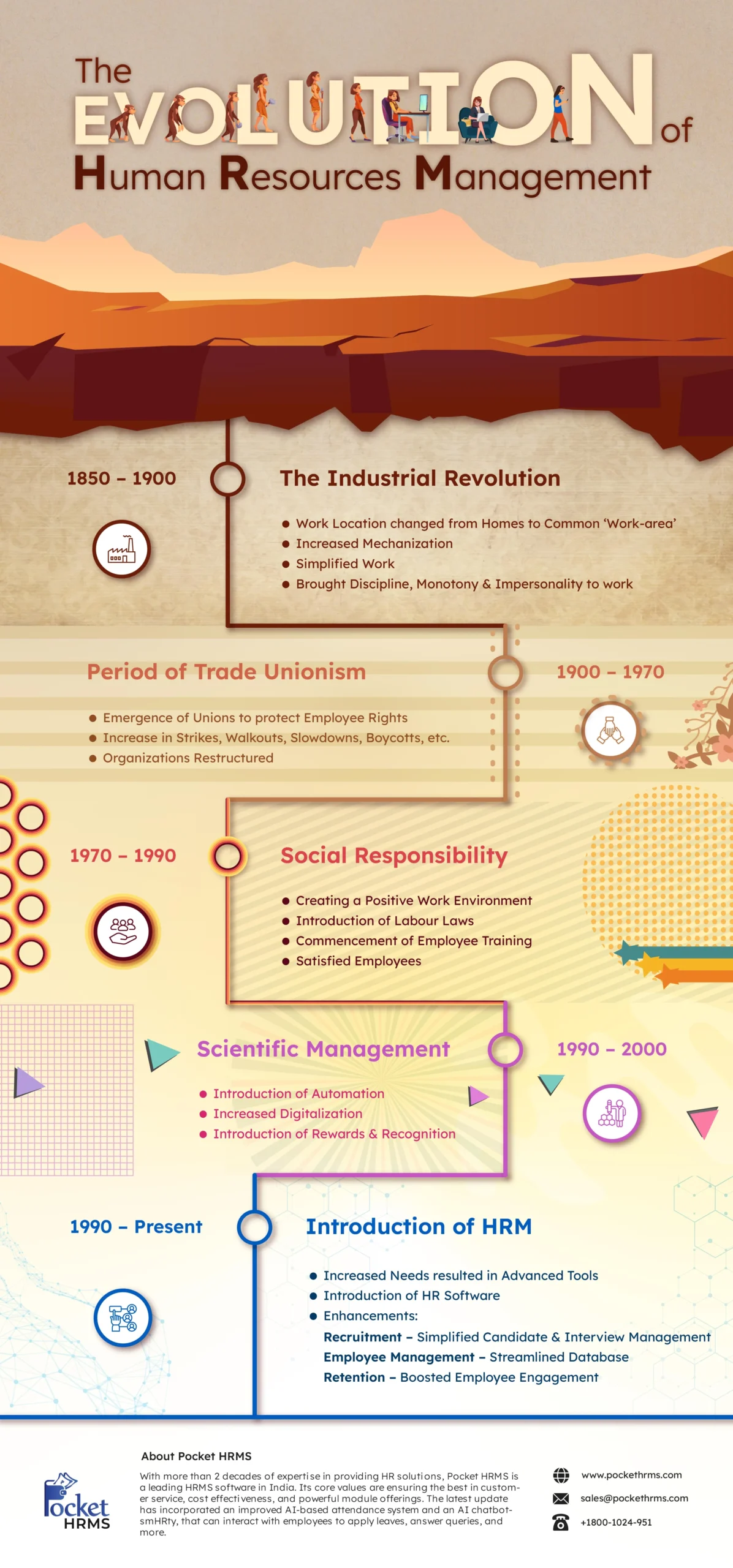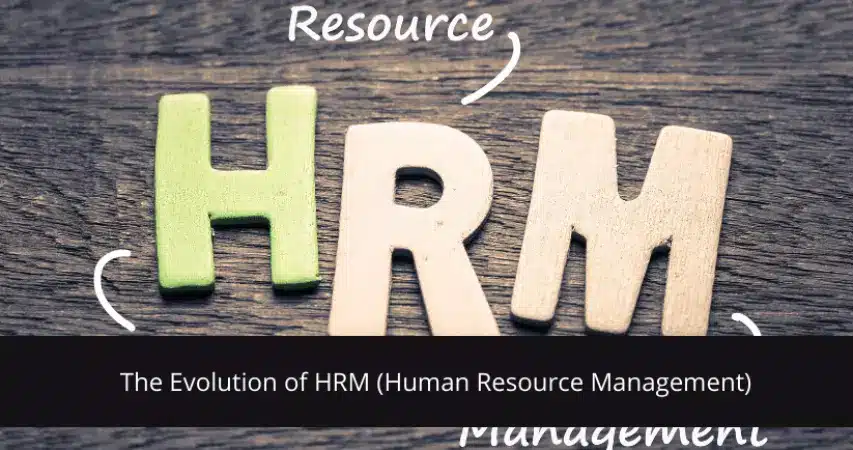Human Resource Management (HRM), being the department responsible for maintaining discipline, has come a long way. The term HRM is relatively a very new term for handling employees in every organization. It is still evolving and will keep on evolving to keep up with the changing world.
The evolution of HRM (Human Resource Management) terms is of very recent origin. It began revolving around the 1980s. During the ancient period, for a long time, goods were produced mainly by skilled craftsmen and artisans. They were responsible for handling all the processes, generating it, producing it, and finally selling it. Let us have a look at how the evolution of the concept of human resource management came into existence.
Generations of the Evolution Of HRM
Human Resource Management (HRM) has evolved over time to meet the changing needs of organizations and the workforce. Here are some of the key types of the evolution of HRM, those are;
- Administrative HRM
- Behavioral HRM
- Strategic HRM
- International HRM
- Digital HRM
1. Administrative HRM
The earliest form of HRM was administrative, where HR was primarily responsible for record-keeping and compliance with employment laws and regulations.
This approach focused on transactional activities, such as hiring, payroll, and benefits administration.
2. Behavioural HRM
In the 1950s and 1960s, HRM evolved to focus on the behavioural aspects of managing employees.
This approach emphasized employee motivation, communication, and leadership development. It also saw the emergence of performance management systems, employee training and development programs, and team-building initiatives.
3. Strategic HRM
Strategic HRM emerged in the 1980s and 1990s as a response to the changing business environment.
This approach focuses on aligning HR strategies with business strategies and objectives. It emphasizes the development of high-performance work culture, the evolution of human behaviour, talent management, and workforce planning.
4. International HRM
With globalization and the rise of multinational corporations, HRM has evolved to include an international dimension. International HRM focuses on managing employees from different cultures, in different countries, and with different legal requirements.
It also involves developing global HR policies and practices that balance standardization with local adaptation.
5. Digital HRM
In recent years, The evolution of HRM includes digital technologies and analytics. Digital HRM encompasses the use of HR information systems, online recruitment, e-learning, social media, and data analytics to enhance HR operations, improve decision-making, and optimize the employee experience.
These are some of the key types of the evolution of Human resource management, and it’s important for organizations to understand these changes and adapt their HR strategies accordingly to meet the needs of their employees and the business.
Also Read: Human Resource Management: The Advanced Guide 2023
Evolution of HRM (Human Resource Management) – The Industrial Revolution
Managing workers at companies began at the time of the Industrial Revolution during the late eighteenth century. Before this era, many large organizations existed, but without the advanced technology, it was hard to maintain them. During this time, the work atmosphere was very unfavorable and the employees used to put in endless hours in the company for very little pay.

FW Taylor introduced scientific management in the twentieth century. He gathered that there was ‘one best way’ to handle every role in every company to make it run more efficiently and smoothly. Taylor examined the job and narrowed it down into essential elements, i.e. job specialization.
He believed that employees could be trained at one job role to become an expert, but he completely ignored the fact that doing the same job every day will get boring and mundane for the employees. During this Revolution, science and technology started being applied to all elements of work in modern industries. This affected every Human Capital Management in many ways such as;
- The area of the job for all the employees changed from their home to a common area, where everyone performed tasks under the same roof. The production techniques evolved from manual to machines.
-
The introduction of mechanization made work so easy with the evolution of HRM human resource management constantly.
- With the help of computer technology, controlling industrial activities became very productive and efficient. Inventory control, production control, method control, manpower control, and financial control had all become very efficient with the introduction of computerized procedures.
- The expanded use of machines resulted in a vast change in employment. Working the machinery required skilled knowledge, which many employees did not have. This ended up making them unemployed and helpless.
In conclusion, the Industrial Revolution brought about discipline, monotony, materialism, job displacement, work interdependence, and impersonality. In economic terms, the revolution increased the accumulation of capital and goods to a large extent.
Consequently, commerce and business were highly accelerated, entrepreneurs and owners performed well, but the average citizen poorly failed.
Also Read: 8 Primary Objectives of Human Resource Management (HRM)
Evolution of HRM (Human Resource Management) – Period of Trade Unionism
Soon after the factory system surfaced, many employees began to get together to discuss their common dilemmas. Every employee was forced to work for long hours under dangerous conditions, for practically no wage. This encouraged the employees to join together and protest to prove their worth and importance to an organization.
They used different kinds of techniques like strike, walkouts, slowdowns, boycotts, picketing, and sabotage. Even physical force was used at times. This, however, proved to be a success, as without the employees the companies would come crashing down. The employers were forced to listen to every demand of all the employees.
New organizational units were created especially to deal with the method improvements, the study of wages, and more attention was paid to the needs of every employee.
Development and evolution of HRM ( Human Resource Management)– Social Responsibility
As seen above, the earlier employers were not sympathetic towards their workers and their needs. With time, they started to realize the importance of every employee and started giving them the importance that they deserve. The companies started creating a positive work environment where the employees were satisfied and hence started showing more productivity.
Labour laws were renewed according to which child labor was abolished. The workers were given proper training on how to use the machinery. High wages and good working conditions helped the workers in being more productive, which in turn contributed to the growth of a company.
Also Read: International HR Day 2024
Growth and Evolution of HRM – Scientific Management
The scientific management era began in 1900 and reached its peak by 1930. It was a major revolution and thus has managed to stay somewhat alive to date. Handling everything manually was getting exhausting for the employees and was hampering their productivity and efficiency.
There was a need to introduce new advanced technology which would eliminate the burden on the employees. Employees used to perform slowly as they used to think that if they performed at a fast pace, it would result in a grave error, which could cost them their jobs. This resulted in plenty of time wastage and loss of productivity. Employees were forced to take up jobs outside of their comfort zone and skills.
Not having knowledge about that field, hampered the credibility of an employee as well as the company. Thus, Taylor introduced the best way to solve this, by picking the right man for the right job. By putting the suited employee for the right job with the correct tools, companies were able to make significant improvements in productivity. This was done by offering the employees great economic incentives and higher daily wages.
To boost up the morale of every employee, the reward and performance management system was introduced. This created a healthy competitive environment by encouraging employees to perform harder to achieve rewards. Scientific management included a lot of essential elements such as;
- Task Planning
Scientific task planning entails the total number of hours an employee can perform every day, which is called a fair day’s work. The management decides in advance what task needs to be done by which employee and within what amount of time. The final goal is to make maximum utilization of resources available in a timely sequence to promote maximum productivity and efficiency.
- Time Study
Time and motion studies were introduced to avoid wastage of time and resources. The same task was given to different employees, and the hours are taken by everyone to complete it was noted. This helped in taking out the average time required to complete a particular task. Fatigue studies were also conducted, where the boredom and monotony caused due to a particular task were noted.
- Standardization
Various standards were set up in advance to ensure that the employees are clear about the objective and target. It was also used to avoid wastage of resources and improve the work quality.
- Wages Bottomed on Productivity
To ensure that the employees are giving their best and not taking advantage of the resources, wages were given out based on work done in the lowest amount of time. According to this, an employee who finishes the entire work on time gets paid a higher wage than the worker who doesn’t complete the task at a given time. This creates a sense of healthy competition, ensuring that the employees give their best to earn a maximum wage.
Evolution of Human Resource Management – Introduction to HRM
As time changes, the techniques need to change too. With the coming of advanced hr technology, a need for a better system emerged to handle the employees in every organization successfully. Over the years the evolution of HRM concept has increased and is continuing to do so.
The integration of HRMS software in businesses is a tried and tested method to improve productivity and increase efficiency. With the numerous benefits of human resource management, many companies are taking advantage of it, and needless to say, are very happy with the outcome. With the increase in the number of companies and their employees, a single person could not handle the administrative tasks of everyone in the organization.
HCM software was created to develop and handle all the tasks systematically and efficiently. Right from attracting candidates, to their recruitment, onboarding, and retention. Everything is now handled by a human resource department. The three key responsibilities of HR are;
1. Recruitment
In today’s competitive business world, recruitment has become a wearying task. Recruitment management system companies are competing with each other neck-to-neck, to find the best potential candidate for their firms. For any job role, there are numerous applicants. It is the responsibility of human resources to find the perfect candidate for the company.
2. Onboarding
When new hires join the organization, they have expectations and aspirations for their job. The human resource department ensures that the onboarding of every new hire is easy and seamless. They introduce an employee to the rules and regulations of the company and make sure that the goals and targets of the new hires are aligned with that of the organization.
3. Retention
The most important role of the human resource department is to make sure that their best employees are happy and satisfied with their jobs. They don’t want the company to lose a crucial asset. Human resource organizes various activities and gives appraisals and rewards to deserving employees. This helps the employees in being satisfied with their job, thus helping the company to retain them for the long haul.
Thus, the growth and evolution of HRM (human resource management) have come a long way. With the advanced technology and software, managing the employees in every organization has become smooth sailing for human resources.
Also Read: 126 HR Quotes to Inspire and Empower HR Professionals
Conclusion
Human Resource Management (HRM) has undergone several types of evolution over the years to meet the changing needs of organizations and the workforce. From administrative HRM to behavioural HRM, strategic HRM, international HRM, and digital HRM, each evolution has brought a unique focus and approach to managing employees.
HRM has been in between It is important for organizations to understand the different types of HRM evolution and adapt their HR strategies to meet the current business environment and the needs of their employees. By doing so, they can create a high-performance work culture, manage talent effectively, and achieve their business objectives.
Pocket HRMS is a new-age HR software with integrated modules supporting functions of human resource management. To learn more, contact us here – sales@pockethrms.com










